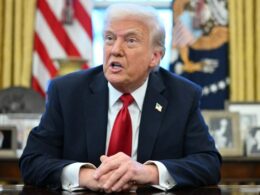Stay informed with free updates
Simply sign up to the EU energy myFT Digest — delivered directly to your inbox.
The EU will court the US for more gas to assuage President Donald Trump while also slashing red tape to boost renewable power capacity this year, the bloc’s energy commissioner has said.
The European Commission expects record renewable capacity to be installed in the EU in 2025.
But Dan Jørgensen said the green push did not preclude potential commitments to buy more US liquefied natural gas, as part of a response to Trump’s tariffs.
The US president issued a 90-day pause and lowered most of the tariffs on Wednesday, shortly after they came into force.
Trump on Monday had suggested that the EU buy about $350bn of US energy in order to reduce its trade deficit, simultaneously dismissing an overture from Brussels to do a “zero-for-zero” tariff deal on industrial goods and cars.
The US is already the biggest supplier of liquefied natural gas to the bloc, accounting for 45 per cent of its imports in 2024 at a value of about $13bn.
“There is potential for us to buy more LNG from the US but of course it needs to be on conditions that are also in line with our [green] transition,” Jørgensen said, adding that he had signalled this to the US energy secretary Chris Wright. But there is little Brussels can do other than encourage companies to sign contracts.
The European Commission expects a record 89 gigawatts of renewable power capacity to be installed in the EU in 2025, including an additional 19GW of wind power and 70GW of solar. That’s despite the global economic turmoil and complaints from industry about long waits for permits and poor grid connections.
Jørgensen said renewable power was “essential” to bring down high energy prices and end the bloc’s reliance on imports of Russian fossil fuels.
“We are all well aware that the high energy prices we are paying are not sustainable in the global competition in the future,’’ he said. ‘‘We have spent more money buying fossil fuels from Russia since 2022 than we have given in aid to Ukraine”.
Jørgensen will announce the figures for renewable deployment at an industry conference in Copenhagen on Thursday in an attempt to encourage offshore wind investors pummelled by the impact of Trump’s fossil fuel agenda to push ahead with projects.
Rasmus Errboe, chief executive of the world’s largest offshore wind developer Ørsted, warned on Wednesday that Europe’s wind industry was at risk of a “downward spiral” because of high costs and supply chain disruptions.
The EU approved its initial response to Trump’s tariffs on Wednesday, after he announced the sweeping measures which amount to the biggest trade war since the 1930s.
Trade body WindEurope said it expected new wind power capacity in Europe to increase 34 per cent this year compared with 2024, but that new installations last year had been lower than expected, with progress held up by ongoing issues over permits, and bottlenecks for connections to the grid.
The solar industry warned that year-on-year capacity growth had slowed dramatically from 53 per cent in 2023 to 4 per cent last year for similar reasons.
Ørsted is one of several European companies whose US projects will be hit by Trump’s tariffs on aluminium and steel because of their reliance on imported components from Europe.

EU solar sector exports to the US are ‘‘relatively small’’ according to industry body SolarPower Europe, but the impact could be “significant” for companies involved in exporting certain key components.
Jørgensen said that the EU could benefit from the turmoil caused by the tariffs and the economic fallout: “I think this crisis that the world economy is in right now will make it even more attractive for companies to seek safe havens in places where there is predictability and Europe is such a place.”
He said that the bloc would not backtrack on its green agenda but wanted to simplify rules governing renewable energy. Average wait times for permits should be cut from between five and seven years to just six months, he said, adding that “nature protection directives are part of the challenge” and would have to be addressed.
Source link









